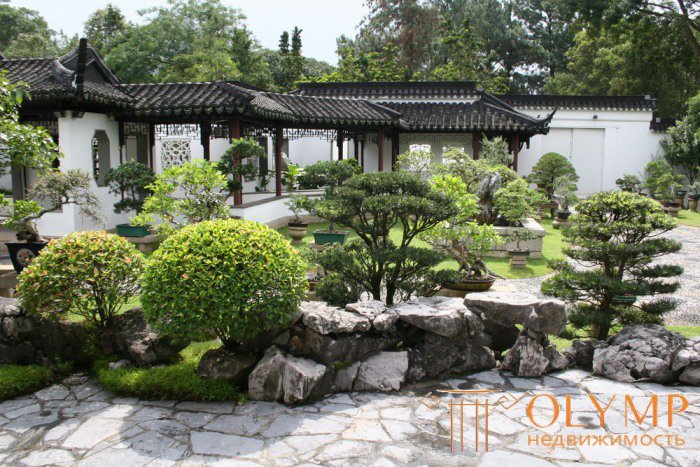
In temperate latitudes, cultivation of indoor bonsai is very difficult, so these plants, as a rule, are short-lived. More successful cultivation of garden bonsai contained in the open air.
Garden bonsai suffer if they are kept at room for a long time, as the room air is too dry and warm for them. When keeping plants in fresh air, problems rarely occur. In summer, the plant should be shaded from direct sunlight, and in winter should be covered from snow (rain) and wind. Fruit and flowering bonsai for a few hours put on a well-lit place. The garden bonsai includes the Chinese juniper, the cypress-pea fruit, the Kempfer larch, the Japanese cryptomeria and the common pine, as well as the Japanese maple (Japanese) and gray elm (Dzelkovo serrate). Virtually any hardy plant can be grown as a garden bonsai.
The idea of indoor bonsai was born not in the East, but in the West - in Germany. Room bonsai are more endurance than garden. However, they require high humidity, so plants should be kept away from heating appliances. Room bonsai fear drafts.

As a rule, the humidity in the urban area is insufficient for bonsai. How can this problem be solved?
The most expensive, but not the most effective way to establish the optimum humidity of the air - an electric humidifier. Humidifiers have a number of disadvantages: large size, high cost of maintenance, noise effects.
A simpler way to solve the problem is to install bonsai in a flat vessel or on a plastic tray filled with water. The bottom of the vessel (tray) must be laid out with small pebbles or a grate and a pot of plants should be placed on top of them. The amount of water must be maintained at the same level. The effectiveness of this method of air moistening will increase if a vessel with water is placed above the heating system.
To increase the humidity of the air, it is recommended to spray the plants with water. However, this procedure gives only a short-term effect, so it must be regularly repeated. Spraying should be done in the morning, so that the plant has time to dry in the evening.
Watering.
The soil in the vessel with bonsai should be constantly wet (not dry, but not wet). Dryness of the soil can be determined by touch or light color. A dry crust on the ground does not necessarily indicate dryness of the entire soil.
Water should reach the bottom of the vessel. In case of poor water permeability of soil, watering should be repeated 2-3 times, until every grain of sand is moistened. In summer, bonsai require more water than in winter, which is associated with more intensive growth of the plant during the warm period. Subtropical plants are watered as rarely as possible in summer: the soil should be relatively dry. Tropical plants do not tolerate cold water at all.
The best water for irrigation is talaya. You can also use tap water, which is defended before use for several hours: water gets room temperature and removes dirt and mechanical impurities.
The soil.
Ready soil for indoor plants, commercially available, is not suitable for bonsai! As a rule, such a soil contains many tiny particles. In extreme cases, it can be used as an additive to the main ground.
Game: Perform tasks and rest cool.5 people play!
Play game Conditions of the maintenance of indoor bonsai.
According to the demands of home bonsai can be put on one level with the most fastidious houseplants. Incorrect content will either destroy bonsai, or make it less attractive and become an ordinary plant, but not a miniature tree.
Game: Perform tasks and rest cool.5 people play!
Play game When installing additional lighting lamps, please note the following rules:
- The closer the lamp is to the plant, the more efficiently it is used. However, do not forget about thermal radiation!
- All lamp light should be directed towards the plant. - For each square meter of the illuminated surface must be at least 70 watts. It is considered that the lamp is set at a distance of 25-50 cm from the plant. - In winter, the duration of the day should be increased by 4-5 hours.
Subtropical types of bonsai (myrtle, olive, pomegranate, rosemary) are kept in winter at a temperature of 5 to 15 C, and in summer they are carried out to the open air (to the balcony).
Tropical species all year round contain at a temperature of 18 to 25 C. In summer, the plants are left indoors. Tropical plants are not recommended to be put on stone window sills if the heating system does not pass under them.
The higher the temperature of the plant, the more light, water and nutrients are required. The lower the temperature, the less abundant the watering and feeding of the plant should be.
Что бы оставить комментарий войдите
Комментарии (0)